Last Updated on 11/23/2022 by Desmond
Various fruit-blended teas always got lots of fans. One of the most popular is Earl Grey, a black tea blend with bergamot, which gets a charming citrus scent. Although Earl Grey has existed for a long time, another fruit-blended tea has a much longer history. Tangerine Pu-erh Tea, an ancient and unique Pu-erh from China, which flavored with tangerines.
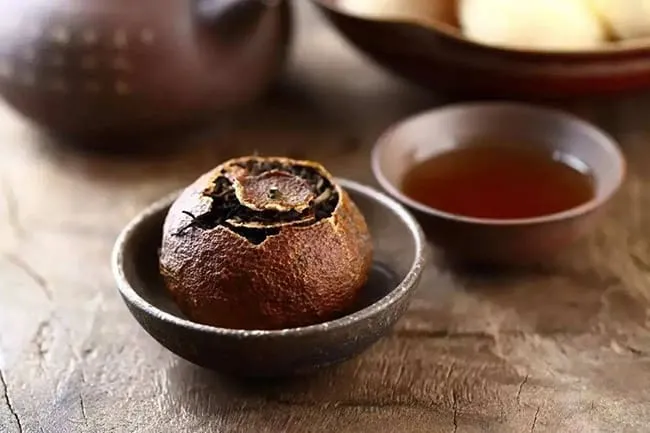
CONTENT
What Is Tangerine Pu-erh Tea?
It was mentioned in The Classic of Tea that the ancients ever had a habit of brewing tea with Chenpi. Chenpi is the tangerine peel after aging for a long time, a TCM herb with a mild and friendly flavor. You can relieve sore throat by just brewing it with hot water.
In the record, Tangerine Pu-erh was born in the Qing dynasty(1636-1912). It was said that there was a man named Luo Tian Chi, who ever took office in Yunnan. He fell in love with the local Pu-erh tea and brought some back home after retiring. One day, his wife makes him a pot of Pu-erh with tangerine peel infusion for brewing. That was a mistake, but Luo tried, and was surprised to find that Chenpi and Pu-erh could create such a wonderful flavor. Thus, he got inspiration and invented Tangerine Pu-erh Tea.
Tangerine Pu-erh has an attractive appearance; it looks like just a dried and tainted tangerine, and the top is cut off as a cover. Open it, you can see dark ripe Pu-erh leaves jammed full inside. Leaves keep aging in it and absorbing the fresh scent of tangerine. In the preparation, you can brew it with the whole fruit or just part of it.
Ripe Pu-erh tea is always loved by fans with its mellow and smooth mouthfeel. But it lacks an obvious fragrance like black tea and green tea, an attraction to the sense of smell, the aftertaste left more on the tongue but not full the mouth. After scenting with tangerine peel, Pu-erh leaves get an impressive aroma. Moreover, it also brings a fresh, lively, orange taste, making the tea not give an old feeling anymore but younger.
How Is The Tangerines Pu-erh Tea Processed?
Process Tangerine Pu-erh requires fresh tangerines, so most processing is manual to avoid breaking the fruits.
After the freshly picked tangerines have been screened, workers use a special tool(a T-shape pipe) to cut a hole in the top. The holes are hard to get a uniform size using a knife for cutting.
Afterward, workers take the pulp out with a plier and clean the lefts thoroughly with a spoon. Then rinse the shell to avoid the juice affecting the tea flavor. At last, preliminary dry the peels.
After the surface dried, workers tenderly filled the ripe Pu-erh leaves in the tangerine shell. The leaves can’t be crammed too much or will be pushed out after the body is roasted. And it also requires room for leaves to breathe and absorb scent.
The following is the most important step – drying. There are 3 common ways:
Sun Drying
Sun drying is the most traditional way. On sunny days, place the tangerine Pu-erh teas outdoors, drying them with the sunshine. It cost about ten to thirty days, the long time will make the flavor of the peel and tea mix more naturally. The sun-dried tangerine Pu-erh shows green and black on its surface, but darker, the scent of the infusion is softer.
The sun-dried tangerine Pu-erh tea is totally dried, it also needs 1-3 years for aging, and the flavor will become the best. Besides, continuous good weather is rare. Thus, tea merchants won’t take this method in bulk production.
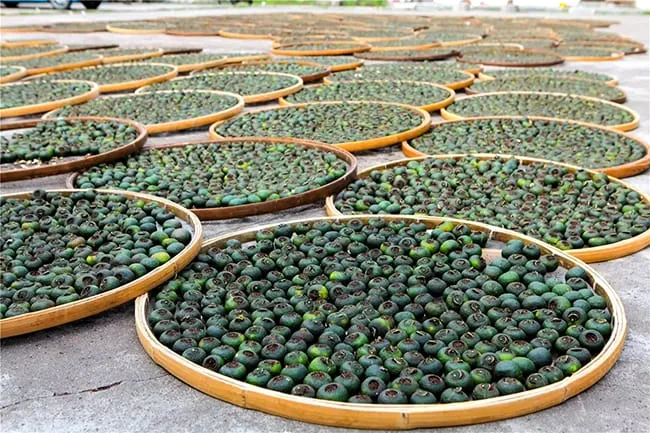
High-temperature Roasting
Some tea merchants may take high-temperature roasting with machines to dry the tangerine Pu-erh tea. It will reach 70-80℃, and the tea becomes dried soon. The high-temperature way costs less time, and it won’t affect by the weather; most of all, the final products do not need to age.
However, high-temperature roasting leads to a layer of tar cover on the surface, which looks greasy. The leaves inside the fruit can’t be transformed well and the flavor has no chance of improving. So high-temperature tangerine Pu-erh tea has no value in aging and belongs to a low-grade product.
Low-temperature Roasting
Drying under 45℃ with machines. Low-temperature roasting costs more time than high-temperature, but it retains the chance for leaves and peels to age. It also not be affected by the weather. This way is undoubtedly the best for cost and quality control; most tea merchants will take this method for drying tangerine Pu-erh tea.
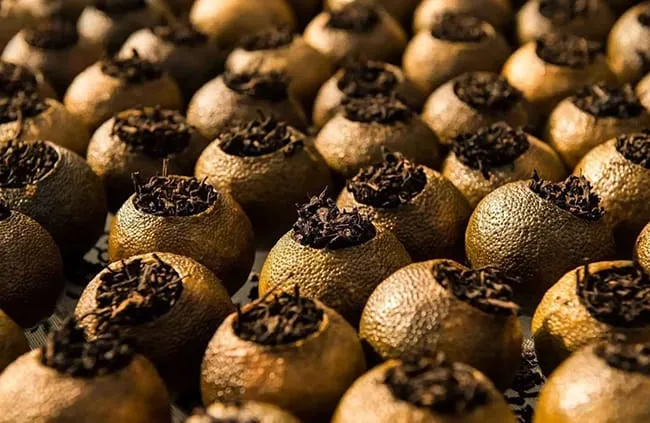
What Is Tangerine Pu-erh Tea Good For?
The tangerine peel not only improves the Pu-erh tea flavor, but you can also get more benefits from it except for the Pu-erh ones. Because they will be brewed together.
The aged tangerine peel, which scientists called Citri Reticulatae Pericarpium (CRP), is a traditional Chinese course and TCM ingredient. Sometimes it will be pickled into a snack. It needs over 3 years of aging to get medicinal and health care effects that accord with the standard of TCM. Just brew it with hot water, and you can get the following benefits:
- increasing appetite
- moisten throat
- calming coughs
- remove phlegm
- invigorating spleen
The above are the benefits description of the aged tangerine peel by TCM. Modern pharmacology studies show that CRP contains rich flavonoids, volatile oil, polysaccharide, etc. It also can help:
- antioxidant
- antimicrobial
- reduce lipid
One thing worth knowing is that the study also shows the 3-4 years aged tangerine peel has the best antioxidant effect. But as the aging time goes on, this effect goes down. Besides, the fresh peel has a superior antimicrobial impact than the aged one.
Common Tangerine Pu-erh Tea Types
Except for different drying methods, tangerine Pu-erh tea is also classified in other ways. They have gaps in price, appearance, size, and even health benefits.
Tangerine Pu-erh Teas
The authentic tangerine Pu-erh tea is made from the tangerines grown in Xinhui, Guangdong. But its yield has a limit. So many products are also made from tangerines grown in other regions(you need to check the product’s information clearly). Although their quality and health value aren’t as good as the Xinhui ones, they also have good taste, and the price will be more friendly. According to the different harvest seasons, tangerine Pu-erh tea is also classified into:
Small Green Tangerine
Processed with the immature tangerine, the peel is still green. The oil ketones are the richest at this moment, the aroma is fresh and strong. The small green tangerine Pu-erh tea has a small size, one just for a brew. It is also the most famous type of all.
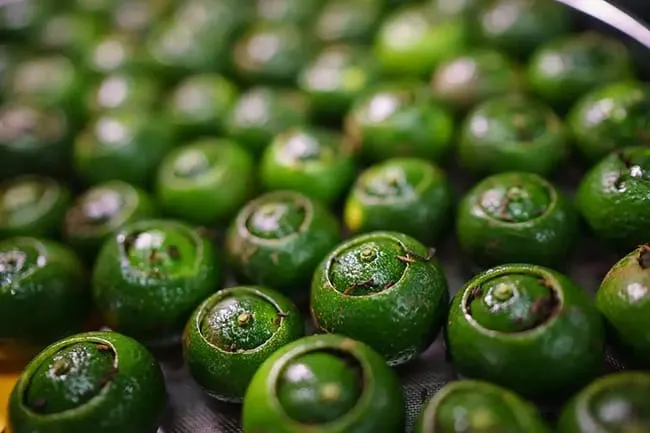
Second Harvested Tangerine
It is also called the second red tangerine. The surface of the fruit starts getting yellow, but not through. Second harvested tangerine Pu-erh tea tastes sweet, with a slightly bitter.
Big Red Tangerine
Big red tangerine Pu-erh tea is made with completely mature tangerine. It has a big size, people usually break it for several consume. The infusion tastes mild and sweet.
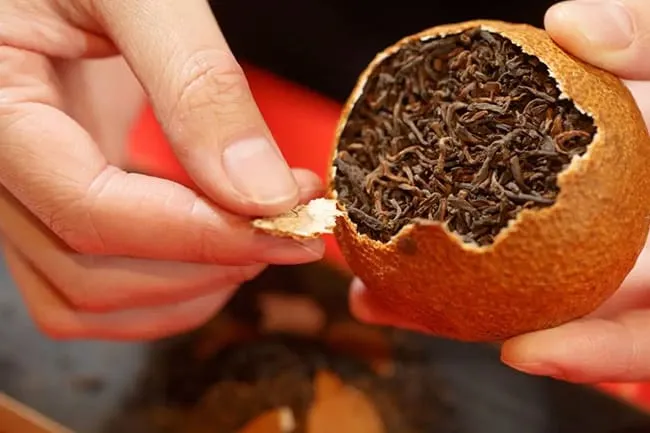
Aged Tangerine Peel Pu-erh
Aged tangerine peel Pu-erh tea is a cheaper substitute. Merchants blend ripe Pu-erh loose leaf and aged tangerine peel chips for sale. Typically, it’s in small individual packaging. In this situation, both the leaves and peel chips are low-grade. It tastes strong but rude. However, some tea fans also like adding pieces of aged tangerine peels when brewing the Pu-erh they collected; that’s one popular Pu-erh tea brewing way.
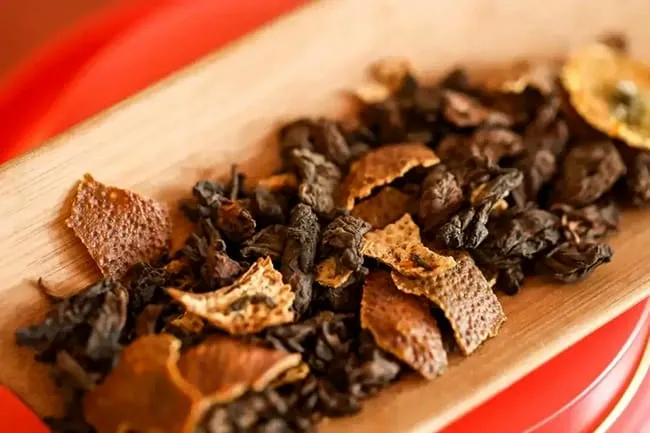
Mandarin Orange Pu-erh
Mandarin orange and tangerine are two different fruits, and people usually confuse them. You can check here to know what’s different between them. No matter the flavor, scent, and health value, the mandarin orange peel is far from the tangerine one. But due to its size being similar to the big red tangerine, and its cost being lower, some illegal merchants use it for deceitful sales. Fortunately, it won’t harm your health.
How To Prepare Tangerine Pu-erh Tea?
The making way of tangerine Pu-erh tea depends on its size. For the small green tangerine, you can put it whole in a Gaiwan. If you worry about the flavor release being slow or incomplete, you can use a tea needle to stab a few holes. For the second harvested and big red tangerine, which is big, you need to take a suitable amount of leaves out, then break some peels for brewing together. The following are the conventional making steps:
- Clean and preheat the teawares;
- Put the leaves and peels in a Gaiwan;
- Fill in 100℃ water, then pour it out immediately. This is to remove the dust got during aging, and preliminary moisten the leaves and peels;
- Refill hot water. The first brew just requires 3-5 seconds. For the following infusion, you can extend 2-5 seconds each suitably;
- Enjoy
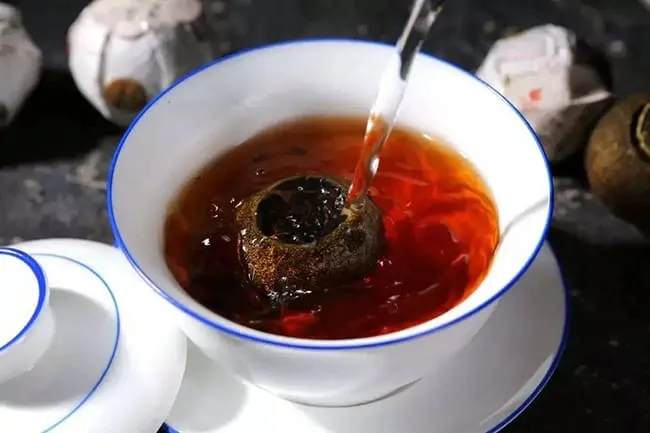
Storage And Aging
Pu-erh tea and tangerine peel both need aging to improve the flavor; the longer time, the better. Typically, the tangerine Pu-erh teas sold on the market have aged for a period of time. What you need to do is to avoid it from going bad during storage.
Avoid Damp
The dried leaves and peels easily absorb the water in the air and lead to mold. Do not store the tea in a damp environment.
Keep Away From The Sunshine
All teas need to keep far away from the sunshine, and it’s more important to tangerine Pu-erh tea. The photochemical reaction will affect the flavor of the leaves and peels. So tangerine Pu-erh is usually packed with paper, which helps to keep it dark and dry.
Insect Prevention
The aged tangerine peel still contains sugar, which easily leads to bugs breeding. Compared with the green tangerines, the red skin ones are easier to be in this situation. You need to check the teas during aging regularly. You can only give them up once them breeding bugs.
Proper Temperature
Tangerine Pu-erh tea needs to be stored under normal temperature. Do not put it into the fridge, the low temperature will make the transformation go slowly. If you live in a cold place, do not try to warm them too, it will also affect the flavor.
Prevent The Bad Smell
The dried leaves and peels also easily absorb the smell from somewhere else. The storage place should keep far away from areas like the kitchen and dining room. However, it also needs to be ventilated. During the aging process, the tea needs air to help the flavor transform; you can’t seal it tight.
Related Reading: